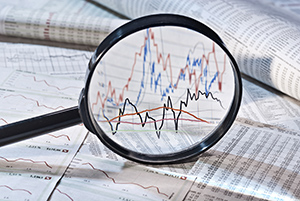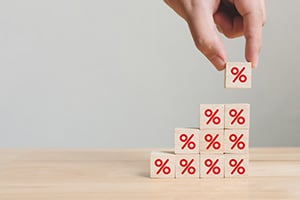Last week was full of important economic updates, many of which showed that the economic impact from the Omicron variant was relatively muted compared to earlier waves of the pandemic. The January retail sales report was a highlight, as sales growth experienced its best month since last March. This will be a quieter week for reports, with only three major releases scheduled that will provide updates on consumer confidence, personal income and spending, and durable goods orders.
News
More Stock Market Turbulence: Could It Get Worse?
Yesterday was another bad one for the market, with the S&P 500 down more than 2 percent. The S&P as a whole is now down more than 8 percent from the peak, with the Dow down about 5 percent, and the Nasdaq down more than 13 percent as of this writing. What is going on—and will it get worse?
Investor Expectations Vs. Reality
This will be a quick post, as I am finishing up a Commonwealth conference. As usual, it has been a wonderful chance to see old friends, make new ones, and have a great time in a beautiful place. It was as I expected, given the great people—and even better meeting planners—who make Commonwealth so special. In this case, at least, my expectations were well-founded and have been fully met. But today I want to talk about expectations in a more general way.
A Broader and Deeper Look at Interest Rates
One of the major current risks to the market is the Fed’s tightening of policy. Much has been written about the Fed’s plans to raise rates, to start downsizing its balance sheet, and so forth. But what has been missing so far is the fact that many of the changes have already been factored in by the market—and what the market seems to be expecting is not really in line with the headlines.
Wordle, Investing, and Russia/Ukraine: What’s the Connection?
Three hot topics at once. Talk about efficiency! Beyond efficiency, though, I do think there is a fairly deep connection here—and one that is worth talking about right now.
Monday Update: Consumer Inflation Accelerates in January
There were a number of important economic data releases last week, with a focus on international trade, consumer prices, and consumer sentiment. The reports showed that continued high levels of inflationary pressure weighed on consumer sentiment to start February. This will be a very busy week of updates, with reports scheduled to cover producer inflation, retail sales, industrial production, new home construction, and the minutes from the most recent Fed meeting.







 Olivia has joined Riverstone Wealth Partners providing knowledge gained from her 15 plus years in management. Olivia has provided services within the financial industry, mortgage industry, and in the non-profit sector. Olivia thrives on providing stellar customer service, accomplishing all goals set before her, and doing the right thing. Olivia’s degree in Business Management allowed her to take on roles that ultimately led her to Riverstone Wealth Partners. Olivia is currently pursuing another degree with an emphasizes in Human Resources, which she has learned over time… is her passion!
Olivia has joined Riverstone Wealth Partners providing knowledge gained from her 15 plus years in management. Olivia has provided services within the financial industry, mortgage industry, and in the non-profit sector. Olivia thrives on providing stellar customer service, accomplishing all goals set before her, and doing the right thing. Olivia’s degree in Business Management allowed her to take on roles that ultimately led her to Riverstone Wealth Partners. Olivia is currently pursuing another degree with an emphasizes in Human Resources, which she has learned over time… is her passion!



 Director of Operations
Director of Operations


 Ashley has been working in the customer service field since she started her first job at age 16. For the past ten years she worked in an office setting handling accounts payable and receivable as well as some receptionist work. She is very excited to learn more about the investment field.
Ashley has been working in the customer service field since she started her first job at age 16. For the past ten years she worked in an office setting handling accounts payable and receivable as well as some receptionist work. She is very excited to learn more about the investment field. Alec joined Riverstone after starting out his post college career on the operations side of an international logistics company working as an account executive. Graduating with a BA in Economics from the University of Illinois at Urbana-Champaign, he quickly developed a strong interest in the financial world. A lifetime resident of the Chicagoland area, Alec is an avid fan of his hometown sports teams. He is also an enthusiast of outdoor activities like fishing, camping, and hiking whenever possible.
Alec joined Riverstone after starting out his post college career on the operations side of an international logistics company working as an account executive. Graduating with a BA in Economics from the University of Illinois at Urbana-Champaign, he quickly developed a strong interest in the financial world. A lifetime resident of the Chicagoland area, Alec is an avid fan of his hometown sports teams. He is also an enthusiast of outdoor activities like fishing, camping, and hiking whenever possible. Carol has a wide variety of experiences and has worked mainly with not-for-profit organizations. She spent 20 years in fundraising and 15 years teaching in the Illinois school system while she raised her younger children. Carol lives in Sugar Grove with her husband, Ron, and their Golden Retriever, Charley. She has four children and two grandchildren. When she’s not working, Carol enjoys spending time with friends and family, running, fishing, bible study, and watching her grandchildren play sports.
Carol has a wide variety of experiences and has worked mainly with not-for-profit organizations. She spent 20 years in fundraising and 15 years teaching in the Illinois school system while she raised her younger children. Carol lives in Sugar Grove with her husband, Ron, and their Golden Retriever, Charley. She has four children and two grandchildren. When she’s not working, Carol enjoys spending time with friends and family, running, fishing, bible study, and watching her grandchildren play sports. Wealth Advisor
Wealth Advisor Wealth Advisor / Registered Principal
Wealth Advisor / Registered Principal Wealth Advisor
Wealth Advisor Wealth Advisor / Registered Principal
Wealth Advisor / Registered Principal Wealth Advisor
Wealth Advisor Wealth Advisor Assistant
Wealth Advisor Assistant Registered Relationship Assistant
Registered Relationship Assistant